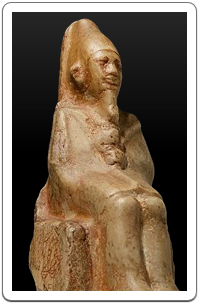According to the statue of the priest Hotepdief, Ninetjer was the successor of Horus Nebre, making him the third king of the 2nd Dynasty. The relationship between these two kings is unknown, as are the names of any wives or children of Ninetjer.His name has been found throughout Egypt and even in a rock inscription in Lower Nubia, which could point to a military expedition against Nubia.

Statue of Ninetjer wearing the White Crown and a short dress, reminiscent of the cloth worn during the Heb Sed festival.
Fifteen years of the reign of Ninetjer have been recorded on the Palermo Fragment of the Annals Stone. Only partially preserved, the first of the year cells refers to the 3rd cattle count. As Ninetjer seems to have had a cattle count every even year of his reign, this year cell coincides with the 6th year of his reign.
The last nine years have been recorded on Cairo Fragment CF1, but are barely preserved at all. The first cell in this sequence refers to the “Appearance of the King of Upper and Lower Egypt”, which usually happened during an odd numbered year. Ninetjer’s last year is recorded in the ninth year cell of CF1, meaning he passed away during an odd numbered year of his reign.
Based on some reconstructions of the Annals Stone, Ninetjer would have ruled for 43 or 45 years, which comes fairly close to the 47 years Manetho has given him.
A small statue showing the king wearing the short dress that was typical for the Heb Sed festival, may indicate that he celebrated his jubiliee at least once.
The 94 years that the Turin King-List credits Ninetjer, are in line with the long reigns that this document has recorded for Egypt’s early kings, but are a huge exaggeration.

Years 6 to 20 from Ninetjer’s reign, as recorded on the Palermo Fragment of the Annals Stone.
Source: Wikipedia
Most of the year cells that are readable provide little more information than the typically recurring ritual activities, such as the biennial “Following of Horus” and the cattle counts that happened every even year and the almost biennial “Appearance of the King” of either Upper or Lower Egypt, or both, in most of the odd years.
The cell corresponding with Ninetjer’s 13th year deviates from this standard and poses somewhat of an enigma. Rather than starting with the “Appearance of the King”, it starts with a reference to the first celebration of an otherwise unattested ritual named “Adoring Horus in the Sky”. The cell also contains two groups of signs that are usually translated as “Hacking of (the city of) Shema-Re” and “Hacking of (the city of) Ha”. Neither of the cities mentioned, has been located, but the reference, if translated correctly, could point towards the striking down of a rebellion, perhaps the precursor of the turmoil that would follow Ninetjer’s reign. Alternatively, it is also possible that “hacking” may not be the correct translation and that “founding” was what was meant, in which case, Ninetjer would not have had 2 cities destroyed, but rather had them built.
There is a great deal of speculation regarding the last years of Ninetjer’s reign, as several Egyptologists have postulated that this king split up his kingdom into two parts, Upper and Lower Egypt, each to be ruled by a different king. While there are plenty of signs of a division of the country after Ninetjer, it is not certain that this was the result of any decision Ninetjer would have made.
Cairo Fragment CF1 of the Annals Stone may refer to the god Seth in the year immediately after Ninetjer’s death, perhaps an indication of the rising cult of this god which would culminate in his name replacing that of the god Horus in the royal titulary during the reign of Seth Peribsen.
Ninetjer was buried in a tomb, consisting of a series of underground galleries and corridors, at Saqqara, near the tomb of Hotepsekhemwi.